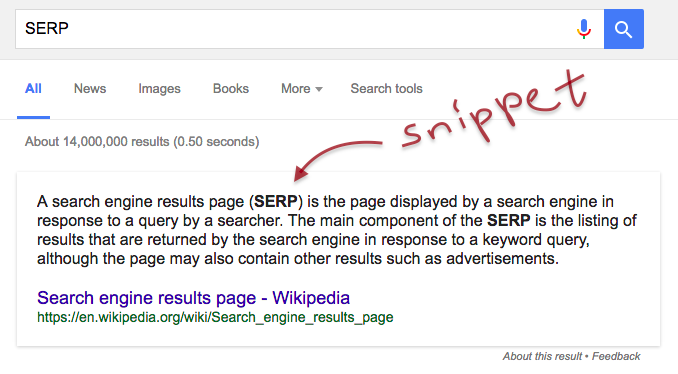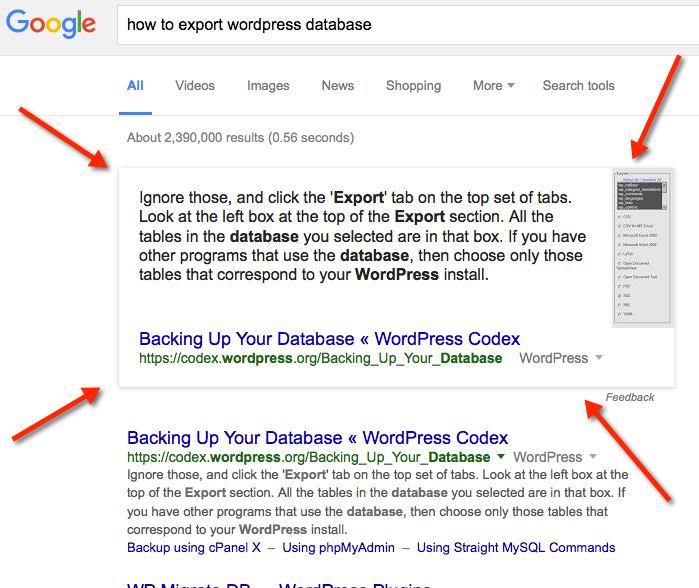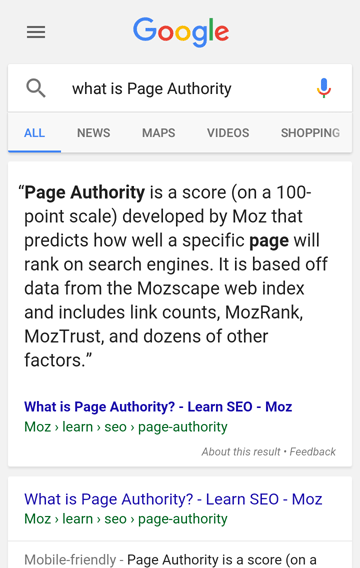Featured snippets: How to get on top of Google results?

“What is SEO?”, “When do people retire in Canada?”, “How much does a pilot earn?”. Here are just a few questions that you can ask Google, whether by typing in your question in the search box, or using Google voice assistant. What do these general questions have in common? Google immediately shows you the answer. This answer is displayed as a featured snippet and offers excellent opportunities for SEO, because your website shows up just below the paid results, yet above websites that are in #1 position. In this article, we will explain how getting your website to display a “feature snipped” is fundamental to your success.
Google is increasingly more competent at understanding and interpreting users’ questions, and the number of search terms that Google itself can address is increasing too. Many companies, blogs, and business either think that the option of getting a featured snippet is only reserved for top sites like Wikipedia or simply neglect it altogether. Today, I would like to tell you more about this underexposed SEO opportunity.
Featured snippet
A featured snippet (not to be confused with a rich snippet) is a special section at the top of the SERPs. This is the place where the answer to the visitor’s question is provided. The question is always answered based on information obtained from third-party websites, although many still think, that it’s some kind of intelligent knowledge-base stored directly in the depths of Google.
The purpose of the featured snippet (also called Google Answer Box) is to give the visitor an immediate answer to his or her inquiry, without having to click-through on any of the search results. If you use Google’s voice assistant, the answer is read to you directly, so you can ask your question and get the answer while driving, without even looking at your phone. If you use a standard browser (mobile or desktop) – the answer to the question can appear in the form of a bold paragraph, summary list or table.
What do featured snippets mean for SEO?
The goal of search engine optimization is to make your website as prominent as possible in organic search results. As you can see in the example above, the featured snippet stands out above all organic search results. You see a piece of text and a supporting image. Since only the paid results are still above the featured snippet, this is also called Position 0. This “Position Zero” has two other major advantages:
1. Big picture on small smartphones
The featured snippet takes up a lot of space on your desktop, but even more on the small screen of your smartphone. Depending on the length of the answer, your website may occupy the largest part of the visitor’s screen as you can see from the example.
Looking at today’s stats, it’s a fact that in 2018 more than 50% of all Google search queries are done via mobile devices. This provides for a great opportunity to take over the entire screen of the user in one shot.
2. The opportunities of voice search
Featured snippets also play an important role in voice searches. The answers that are visible in these highlighted snippets are used by Google’s virtual assistant to address the questions users ask aloud. If users want to know more, they can click on their smartphone and go to your website.
It is expected that by 2020 – fifty percent of all searches will be done via voice search or voice commands. Looking ahead at the technology evolution, by the end of 2019 most homes will have the smart Google Home speaker, which will also be guaranteed to contribute to the number of spoken searches. Now, it is the best time to prepare your website for this evolution in the SEO game.
Now you may ask: Will users still click-through to my website?
The most common argument for not displaying your website in the featured snippets (you can find a piece of code for it on the web), is that there is no reason for the user to click through to the website if the answer has already been given.
Case studies from Search Engine Land and Hubspot show that there is a higher Click-Through-Rate (CTR) at position 0, and that comes as no surprise, because a snipped may not cover the information completely, can be too long to be displayed fully or there are additional questions that the user seeks answers to, and will naturally go with the result that has been presented to him by Google. That’s because we’ve learnt to trust Google so much, we think the first result it shows us – is the most relevant and trusted one.
How can my website show up as a featured snippet?
Unfortunately, it is up to Google to determine whether the information from your website is shown directly in the form of a featured snippet. However, there are factors that play a significant role in this competition, including your domain’s authority, search volume and the formatting of the content. Although there is no magic recipe to guarantee you’ll make it into Google’s featured snippet, I would like to give you a few tips to increase the chance of acquiring this prominent position. Google is continuously expanding the number of questions that it displays answers to, so instead of trying to beat Netflix in your attempt to present featured snipped answering the question “What’s Netflix?”, you can instead direct your efforts into “answering” other questions, that Google still doesn’t seem to have a featured snippet for.
Tip 1. Research what people are looking for
This may sound like a no-brainer, but it is essential to know precisely, which questions potential customers are asking. A handy tool that I use for this is Answer The Public. Enter a relevant keyword on their website and get an overview of related questions that people type into Google. These questions usually begin with: What, How, How Much, When or What.
If you also keep track of search queries on your own your website in Google Analytics, you can check whether there are any interesting keywords or questions that can be implemented.
Tip 2. Check whether an answer to this question is already provided in the Google Answer Box
As for 2018, Google still does not answer all questions itself. Check whether the search engine already displays a featured snippet for the questions you’ve noted when reading Tip #1 above. If there are no results (supply) but at the same time there is sufficient search volume (demand), then it is wise to get started and work your way up to “Position 0”.
If Google already provides an answer to the question, it makes sense to check whether you can beat the competition. Look at the position of your own website, the relevance and especially how you can improve the answer to the question. A side note though is that it’s probably not worth the effort to try and beat Wikipedia.
Tip 3. Ensure the correct layout
It should be clear to Google which content on your website answers the question of the user. You can do this by putting the question (as exact as possible) in the “head” (for example an H1, H2 or H3), with the answer following immediately below. Take extra precautions when working with the code, keep it as clean as possible, without excess Java and other dynamic elements that will only get Googlebot confused.
Researches show that an answer of about 40 to 50 words is the best. As I have already mentioned, the answer can be given in the form of a paragraph, a summary list or a table. Use the correct HTML elements for this but remember to keep it simple.
Tip 4. Always optimize your ranking in organic search results
To come up with an “answer” (featured snipped) on the search results page, fortunately, you do not have to be number 1 in the organic search results with your website. Nonetheless, you significantly increase your chances of displaying that featured snipped if you are in the top five. Even if you have your site on the first page (top 10 results), it is possible to claim this valuable position.
Ready to take over position #0?
The featured snippets offer an excellent opportunity to be prominently present in the search results with the information from your website, and as a long-term benefit, you will be referenced more by other sites, which will in term help your SEO even more. Therefore, get started with the tips above to optimize your content. I am curious about your results, are you already in position 0?









